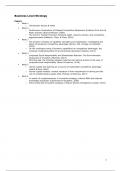Business Level Strategy
Papers:
Week 1
o Introduction lecture & slides
Week 2
o Performance Implications of Delayed Competitive Responses: Evidence from the US
Retail Industry (Boyd & Bresser, 2008)
o The Clock is Ticking! Executive temporal depth, industry velocity, and competitive
aggressiveness (Nadkarni, Chen, & Chen, 2016)
Week 3
o The dynamic interplay of capability strengths and weaknesses: investigating the
bases of temporary competitive advantage (Simon, Hitt, Arregle, & Campbell,
2010)
o On the contingent value of dynamic capabilities for competitive advantage: the
nonlinear moderating effect of environmental dynamism (Schilke, 2014)
Week 4
o Corporate Social Responsibility and Shareholder Reaction: The Environmental
Awareness of Investors (Flammer, 2013)
o Mind the gap: the interplay between external and internal actions in the case of
corporate social responsibility (Hawn & Ioannou, 2016)
Week 5
o Human capital and learning as a sources of sustainable competitive advantage
(Hatch & Dyer, 2004)
o Human capital matters: market valuation of firm investments in training and the
role of complementary assets (Rile, Michael, & Mahoney, 2017)
Weel 6
o In search of complementarity in innovation strategy: internal R&D and external
knowledge acquisition (Cassminan & Veugelers, 2006)
o Entry timing and innovation strategy in feature phones (Klingebiel & Joseph, 2016)
1
,Week 1: Introduction lecture
Strategy objectives
We assume that the general objective of strategy is:
Achieving sustainable competitive advantage leading to above average economic
performance
‘The fundamental basis of above-average performance in the long-run is sustainable competitive
advantage’
What is competitive advantage?
A firm has a competitive advantage if it is able to create more economic value than rival
firms
Economic value
It is the difference between the perceived benefits gained by a customer that purchases a
firm’s products or services and the full economic cost of these products and services
Sustainability of competitive advantage
Sustainable competitive advantage
A firm possesses a sustainable competitive advantage when it has value creating
processes and positions that cannot be duplicated or imitated by other firms and that lead
to the consistent production of above average returns
So what drives profitability?
External versus internal factors
M. Porter (1979):
Attractive industry + favorable competitive positioning → superior profitability
o Locate within attractive industries
o Adopt strategies that modify industry conditions and competitor behavior to
moderate competition
But:
Empirical results industry factors account for a relatively small proportion of inter-firm
profit differentials
J. Barney (1991):
Resources and capabilities of a firm may be more reliable sources of competitive advantage
than market focus
2
,Porter’s Five Forces model (FFM)
‘Industry choice matters for the future profitability of the company’
M. Porter “The Five forces that shape the strategy” , (13’11), Jun 30, 2008
The intensity of competition within an industry is determined by
o Bargaining power of suppliers
o Bargaining power of buyers
o Threat of new entries into the industry
o Threat of substitute products from a different industry
o Competition from industry incumbents
Depends on concentration, diversity of competitors, product differentiation,
excess capacity, exit barriers, fixed costs
Average ROA 1994-2001 by industry
Analyzing competitors: strategic groups
M. Porter: “Industry choice matters for the future profitability of a company”
Questions
o Do all companies in the same industry have the same strategy?
o Within a given industry, what are the main dimensions along which the strategies of
firms can differ?
o By positioning companies along those dimension, is it possible to identify groups of
companies?
Strategic groups:
Strategic dimensions: product range, geographical breadth, distribution channels, product
quality, vertical integration etc.
Yet, most empirical findings: not big difference between profitability between and within
strategic groups
Strategic group analysis can be used to identify different strategic niches within an industry
Strategic groups in the automotive industry (Grant, 2008)
3
, Do differences between firms matter?
If performance is determined by industry structure (porter, 1970s), all firms in the same
industry should perform similarly?
Rumelt (1991, SMJ)
o What is the % of the variance in rate of returns of various business units accounted
for by different actors?
Do differences between firms matter?
Recent work by Wang (2023)
4





